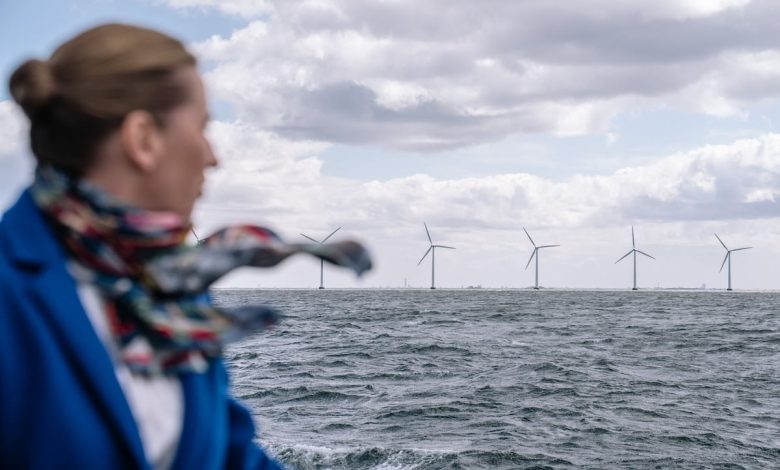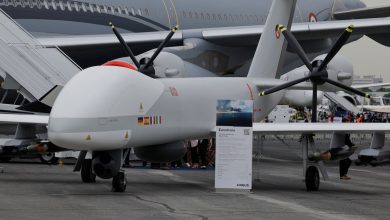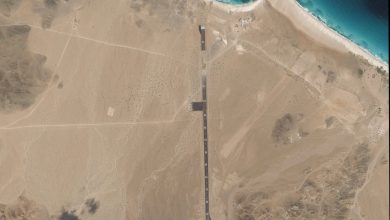Why Sweden nixed new wind farms for fear of missing Russian missiles

BERLIN — Sweden’s government this month blocked the construction of 13 offshore wind farms over concerns that they would shorten the country’s early-warning window for a Russian missile attack.
The decision marks another example in Europe of national security factors seeping into political decisions that were deemed civilian in nature before Russia’s full-scale invasion of Ukraine in February 2022.
In this case, the issue is about two dueling interests: sustainable-energy independence and surveillance of the national airspace. That is because wind farms can interact with radar signals, reducing the quality of the situational air picture or even outright blocking out parts of the sky.
“The reaction time in the event of a missile attack could go from 2 minutes to 60 seconds with wind farms in the way,” Swedish Defense Minister Pål Jonson wrote in a series of posts on X, formerly known as Twitter. They were accompanied by a schematic drawing of the wind farms casting a “shadow” behind them in which missiles and cruise missiles would stay undetected.
RELATED
The perceived threat clearly comes from Russia, with Jonson pointing out that “the proximity to the heavily militarized” Russian exclave of Kaliningrad was “important in this context.”
Experts speaking to Defense News for this story said wind farm radar interference is a known issue. And some expressed concern that as more and more wind farms are built, the effects could get worse unless countermeasures are put in place.
“Radar interference can impede air traffic control, weather forecasting, homeland security, and national defense missions,” U.S. Department of Energy spokesperson wrote in an email to Defense News, while also stressing that “the vast majority of wind projects … pose no significant impacts to radar missions.”
Radar performance
There are a number of ways that wind turbines, and especially large groups of them, can mess with the readings from a radar system. For one, they can show up on the screen because, just like any other object, they bounce back the electromagnetic waves that radar relies on. The fact that they are moving – the blades are spinning, and the turbines can change orientation – can make it more difficult for analysts to filter out the noise and find actual threats in the skies.
With the wingtips rotating at a speed of up to 370 kilometers per hour (around 230 mph), they move fast enough for doppler radars to sense them as moving objects, resulting in a false positive on an operator’s screen.
Benjamin Karlson leads the Wind Turbine Radar Interference Mitigation program at the American Sandia National Laboratories. His team has tested various concepts at mitigating the problem, he said, but “there’s no silver bullet.” Radar-absorbent coating is expensive and leaves the problem of a blind spots; temporary shutoffs lead to losses for the operators of wind farms; and infill, or fallback, radars are but costly workarounds.
Governments and private companies have been aware of the issue for decades, with the topic first being presented to the U.S. Congress in 2006. Considerable research has occurred in both the U.S. and U.K.
In the United States, “the communication between the developers and the federal agencies has grown over the years,” said Karlson. The Department of Defense, Federal Aviation Administration, the country’s weather service NOAA and others all have a stake in approving new wind farm developments. Despite these hurdles, Karlson said he wasn’t aware of a single case where a wind farm proposal had to be denied outright, though adjusting the placement of individual turbines, or tweaking their dimensions, is a more common practice.
“Most potential conflicts are dealt with through minor and routine mitigation measures in the federal project evaluation process,” the Department of Energy said in a statement.
Radar systems vary greatly so what might work for one can be completely ineffective on another. Over-the-horizon radars, for example, might be especially affected by offshore wind farms. As the name suggests, these systems have a much greater range than other radars, which are generally limited to the line of sight of the antenna and so cannot see past the curvature of the earth.
The longer-range variants bounce their beams off the ionosphere layer of the atmosphere before the waves travel back close to the surface – where wind farms can get in the way and may completely block out the signal. “There is no way of mitigating that aside from not building turbines,” said Karlson.
In his announcement, the Swedish defense minister did not specify what radar systems’ signals the country was concerned about blocking, and Karlson said that there was not enough information to make an educated guess.
Additionally, “the wind farms could also lead to reduced intelligence-gathering capabilities and disrupt sensors used to detect submarines,” Jonson said in his announcement. Altogether, the construction would have “unacceptable consequences for Swedish security.”
“Clearly, the Swedish government thinks there is a big concern,” said Karlson.
Energy requirements
Simultaneously, wind energy presents a crucial pillar in the clean energy transition, a topic that has gained exceptional pertinence in a Europe starved for energy since the Russian war in Ukraine. Traditionally, Europe obtained a large part of its energy from Russia, which controls vast oil and gas reserves and over decades built a network of pipelines to European countries to sell its hydrocarbons at a competitive price. While the green-energy transition predates the war, it has been turbocharged by it: Russia has used its leverage over European energy supply as a leverage and a weapon in its hybrid warfare, while European leaders have rushed to ween their countries off of Russian gas and oil.
According to the Swedish Energy Agency, the “supply of electricity in Sweden is stable.” Simultaneously, however, the government agency warned that “Sweden will have rising electricity prices” as a direct result of the Russian invasion of Ukraine.
The planned wind farms would have had the potential to contribute significantly to Sweden’s renewable energy production, with the rejected plans seeing turbines stretching all the way from the Åland Islands along the east coast down to Öresund.
While the government blocked the construction of the 13 proposed wind farms in the Baltic, it also greenlit the construction of the “Poseidon” wind farm off the country’s western – NATO-facing – coast, with a maximum of 81 turbines producing up to 5.5 terawatt hours per year.
Sweden’s government has committed itself to double the country’s annual electricity production in the next twenty years, in anticipation of higher consumption. A buildup of the country’s nuclear power capacity is supposed to bear the brunt of this burden, though critics have pointed out that demand is expected to increase faster than new power reactors can go online.
Similar trade-offs between wind farm construction and radar visibility have had to be made in other European countries. The British and French ministries of Defense have objected to developments over similar concerns, and various other government agencies across the continent have issued guidelines for distances that should be maintained between wind farms and different types of radar stations.
Both energy independence and climate change have increasingly entered the realm of national security in national government across Europe and the world, with leaders seeing them as integral parts of their countries’ defense and prosperity. The Swedish government’s decision points the spotlight on one dimension of this interaction that has, until now, flown under the radar.
Linus Höller is a Europe correspondent for Defense News. He covers international security and military developments across the continent. Linus holds a degree in journalism, political science and international studies, and is currently pursuing a master’s in nonproliferation and terrorism studies.
Read the full article here






